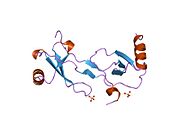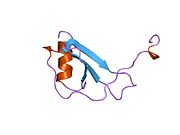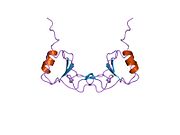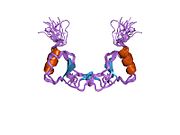
Chemotaxis is the movement of an organism or entity in response to a chemical stimulus. Somatic cells, bacteria, and other single-cell or multicellular organisms direct their movements according to certain chemicals in their environment. This is important for bacteria to find food by swimming toward the highest concentration of food molecules, or to flee from poisons. In multicellular organisms, chemotaxis is critical to early development and development as well as in normal function and health. In addition, it has been recognized that mechanisms that allow chemotaxis in animals can be subverted during cancer metastasis. The aberrant chemotaxis of leukocytes and lymphocytes also contribute to inflammatory diseases such as atherosclerosis, asthma, and arthritis. Sub-cellular components, such as the polarity patch generated by mating yeast, may also display chemotactic behavior.

Tumor necrosis factor is an adipokine and a cytokine. TNF is a member of the TNF superfamily, which consists of various transmembrane proteins with a homologous TNF domain.

Chemokines, or chemotactic cytokines, are a family of small cytokines or signaling proteins secreted by cells that induce directional movement of leukocytes, as well as other cell types, including endothelial and epithelial cells. In addition to playing a major role in the activation of host immune responses, chemokines are important for biological processes, including morphogenesis and wound healing, as well as in the pathogenesis of diseases like cancers.

Chemokine ligand 5 is a protein which in humans is encoded by the CCL5 gene. The gene has been discovered in 1990 by in situ hybridisation and it is localised on 17q11.2-q12 chromosome. It is also known as RANTES. RANTES was first described by Dr. Tom Schall who named the protein, the original source of the name Rantes was from the Argentine movie Man Facing Southeast about an alien who shows up in a mental ward who was named Rantés, the rather clunky acronym was only made to fit the name.

Macrophage Inflammatory Proteins (MIP) belong to the family of chemotactic cytokines known as chemokines. In humans, there are two major forms, MIP-1α and MIP-1β, renamed CCL3 and CCL4 respectively, since 2000. However, other names are sometimes encountered in older literature, such as LD78α, AT 464.1 and GOS19-1 for human CCL3 and AT 744, Act-2, LAG-1, HC21 and G-26 for human CCL4. Other macrophage inflammatory proteins include MIP-2, MIP-3 and MIP-5.

Interleukin 32 (IL32) is proinflammatory cytokine that in humans is encoded by the IL32 gene. Interleukin 32 can be found in higher mammals but not in rodents. It is mainly expressed intracellularly and the protein has nine different isoforms, because the pre-mRNA can be alternatively spliced. The most active and studied isoform is IL-32γ. It was first reported in 2005, although the IL-32 gene was first described in 1992. It does not belong to any cytokine family because there is almost no homology with other cytokines.
Chemokine ligands 4 previously known as macrophage inflammatory protein (MIP-1β), is a protein which in humans is encoded by the CCL4 gene. CCL4 belongs to a cluster of genes located on 17q11-q21 of the chromosomal region. Identification and localization of the gene on the chromosome 17 was in 1990 although the discovery of MIP-1 was initiated in 1988 with the purification of a protein doublet corresponding to inflammatory activity from supernatant of endotoxin-stimulated murine macrophages. At that time, it was also named as "macrophage inflammatory protein-1" (MIP-1) due to its inflammatory properties.
Chemokine ligand 1 (CCL1) is also known as small inducible cytokine A1 and I-309 in humans. CCL1 is a small glycoprotein that belongs to the CC chemokine family.

Chemokine ligand 7 (CCL7) is a small cytokine that was previously called monocyte-chemotactic protein 3 (MCP3). CCL7 is a small protein that belongs to the CC chemokine family and is most closely related to CCL2.

Chemokine ligand 8 (CCL8), also known as monocyte chemoattractant protein 2 (MCP2), is a protein that in humans is encoded by the CCL8 gene.

C-C motif chemokine 11 also known as eosinophil chemotactic protein and eotaxin-1 is a protein that in humans is encoded by the CCL11 gene. This gene is encoded on three exons and is located on chromosome 17.
Chemokine ligand 13 (CCL13) is a small cytokine belonging to the CC chemokine family. Its gene is located on human chromosome 17 within a large cluster of other CC chemokines. CCL13 induces chemotaxis in monocytes, eosinophils, T lymphocytes, and basophils by binding cell surface G-protein linked chemokine receptors such as CCR2, CCR3 and CCR5. Activity of this chemokine has been implicated in allergic reactions such as asthma. CCL13 can be induced by the inflammatory cytokines interleukin-1 and TNF-α.

C-X-C motif chemokine 11 (CXCL11) is a protein that in humans is encoded by the CXCL11 gene.

The chemokine ligand 1 (CXCL1) is a small peptide belonging to the CXC chemokine family that acts as a chemoattractant for several immune cells, especially neutrophils or other non-hematopoietic cells to the site of injury or infection and plays an important role in regulation of immune and inflammatory responses. It was previously called GRO1 oncogene, GROα, neutrophil-activating protein 3 (NAP-3) and melanoma growth stimulating activity, alpha (MGSA-α). CXCL1 was first cloned from a cDNA library of genes induced by platelet-derived growth factor (PDGF) stimulation of BALB/c-3T3 murine embryonic fibroblasts and named "KC" for its location in the nitrocellulose colony hybridization assay. This designation is sometimes erroneously believed to be an acronym and defined as "keratinocytes-derived chemokine". Rat CXCL1 was first reported when NRK-52E cells were stimulated with interleukin-1β (IL-1β) and lipopolysaccharide (LPS) to generate a cytokine that was chemotactic for rat neutrophils, cytokine-induced neutrophil chemoattractant (CINC). In humans, this protein is encoded by the gene Cxcl1 and is located on human chromosome 4 among genes for other CXC chemokines.
CC chemokine receptors are integral membrane proteins that specifically bind and respond to cytokines of the CC chemokine family. They represent one subfamily of chemokine receptors, a large family of G protein-linked receptors that are known as seven transmembrane (7-TM) proteins since they span the cell membrane seven times. To date, ten true members of the CC chemokine receptor subfamily have been described. These are named CCR1 to CCR10 according to the IUIS/WHO Subcommittee on Chemokine Nomenclature.

Chemokine ligand 12 (CCL12) is a small cytokine belonging to the CC chemokine family that has been described in mice. It is also known as monocyte chemotactic protein 5 (MCP-5) and, due to its similarity with the human chemokine MCP-1, sometimes it is called MCP-1-related chemokine. CCL12 specifically attracts eosinophils, monocytes and lymphocytes. This chemokine is found predominantly in lymph nodes and thymus under normal conditions, and its expression can be hugely induced in macrophages. It is thought to coordinate cell movements during early allergic reactions, and immune response to pathogens. The gene for CCL12 is found in a cluster of CC chemokines on mouse chromosome 11.

C-C chemokine receptor type 2 (CCR2 or CD192 is a protein that in humans is encoded by the CCR2 gene. CCR2 is a CC chemokine receptor.

C-C chemokine receptor type 1 is a protein that in humans is encoded by the CCR1 gene.

C-C chemokine receptor type 3 is a protein that in humans is encoded by the CCR3 gene.

NR58.3-14-3 is a cyclic peptide consisting of 11 D-amino acids. It is a broad-spectrum chemokine inhibitor and anti-inflammatory agent.


























